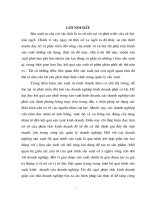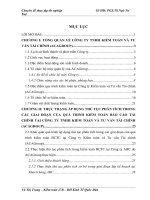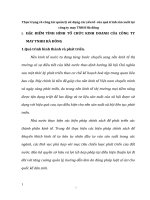ISA 5 các yếu tố của quá trình kiểm toán
Bạn đang xem bản rút gọn của tài liệu. Xem và tải ngay bản đầy đủ của tài liệu tại đây (1.56 MB, 38 trang )
Part Two
Planning and Risk
Copyright 2006 McGraw-Hill Australia Pty Ltd
5-1
Chapter 5
Overview of Elements of
the Financial Report Audit
Process
Copyright 2006 McGraw-Hill Australia Pty Ltd
5-2
Learning Objective 1:
Accounting and Auditing Contrasted
Copyright 2006 McGraw-Hill Australia Pty Ltd
Revised PPTs t/a Auditing and Assurance Services in Australia 3e by Grant Gay and Roger Simnett
Slides prepared by Roger Simnett
5-3
Areas of audit interest
•
Accountable activity of the entity
–
–
–
•
Collection of original accounting data;
Allocations and reclassifications of the associated data;
and
Presentation of results in financial report.
Organisation of the entity
–
–
External relationships
Internal organisational structure.
Copyright 2006 McGraw-Hill Australia Pty Ltd
Revised PPTs t/a Auditing and Assurance Services in Australia 3e by Grant Gay and Roger Simnett
Slides prepared by Roger Simnett
5-4
Learning Objective 2:
Financial Report Assertions and Audit
Objectives
•
Directors and managers make assertions when they
present a financial report.
• Auditors use these assertions to assess risks by
considering different types of potential misstatements
that may occur and designing audit procedures in
response to risks.
• There are three categories of assertions:
–
–
–
Classes of transactions and events;
Account balances; and
Presentation and disclosure.
Copyright 2006 McGraw-Hill Australia Pty Ltd
Revised PPTs t/a Auditing and Assurance Services in Australia 3e by Grant Gay and Roger Simnett
Slides prepared by Roger Simnett
5-5
Financial Report Assertions and Audit
Objectives (cont.)
•
Assertions about classes of transactions and events for
the period under audit:
(a) Occurrence – transactions and events that have been
recorded have occurred and pertain to the entity.
(b) Completeness – all transactions and events that should
have been recorded have been recorded.
(c) Accuracy – amounts and other data relating to recorded
transactions and events have been recorded appropriately.
(d) Cutoff – transactions and events have been recorded in
the correct accounting period.
(e) Classification – transactions and events have been
recorded in the proper accounts.
Copyright 2006 McGraw-Hill Australia Pty Ltd
Revised PPTs t/a Auditing and Assurance Services in Australia 3e by Grant Gay and Roger Simnett
Slides prepared by Roger Simnett
5-6
Financial Report Assertions and Audit
Objectives (cont.)
•
Assertions about account balances at the period end:
(a)
(b)
Existence – assets, liabilities and equity interests exist.
Rights and obligations – the entity holds or controls the
rights to assets, and liabilities are the obligation of the
entity.
(c) Completeness – all assets, liabilities and equity interests
that should have been recorded have been recorded.
(d) Valuation and allocation – assets, liability and equity
interests are included in the financial report at
appropriate amounts and any resulting valuation
adjustments are appropriately recorded.
Copyright 2006 McGraw-Hill Australia Pty Ltd
Revised PPTs t/a Auditing and Assurance Services in Australia 3e by Grant Gay and Roger Simnett
Slides prepared by Roger Simnett
5-7
Financial Report Assertions and Audit
Objectives (cont.)
•
Assertions about presentation and disclosure:
(a)
Occurrence and rights and obligations – disclosed
events, transactions and other matters have occurred
and pertain to the entity.
(b) Completeness – all disclosures that should have been
included in the financial report have been included.
(c) Classification and understandability – financial
information is appropriately presented and described,
and disclosures are clearly expressed.
(d) Accuracy and valuation – financial and other information
is disclosed fairly and at appropriate amounts.
Copyright 2006 McGraw-Hill Australia Pty Ltd
Revised PPTs t/a Auditing and Assurance Services in Australia 3e by Grant Gay and Roger Simnett
Slides prepared by Roger Simnett
5-8
Assertions and objectives for the account balance
of inventory of a manufacturing company
Financial report
Assertion
Existence
Completeness
Rights and
obligations
Valuation and
allocation
Illustrative audit objectives
Inventories included in the balance sheet physically exist.
Inventories represent items held for sale in normal course of
business.
Inventory quantities as per the accounting records include
all products, materials and supplies owned by the company
that are on hand.
Inventory quantities include all products, materials and
supplies owned by the company that are in transit or stored
at outside locations.
The company has legal title or similar rights or ownership to
the inventories.
Inventories exclude items billed to customers or owned by
others.
Inventories are properly stated at cost (except when the
net realisable value is lower).
Slow-moving, excess, defective and obsolete items included
in inventories are properly identified and valued.
Copyright 2006 McGraw-Hill Australia Pty Ltd
Revised PPTs t/a Auditing and Assurance Services in Australia 3e by Grant Gay and Roger Simnett
Slides prepared by Roger Simnett
5-9
Learning Objective 3:
Audit Evidence
Copyright 2006 McGraw-Hill Australia Pty Ltd
Revised PPTs t/a Auditing and Assurance Services in Australia 3e by Grant Gay and Roger Simnett
Slides prepared by Roger Simnett
5-10
Learning Objective 4:
Common Audit Procedures
•
•
•
•
•
•
•
Inspection
Observation
Inquiry
Confirmation
Recalculation
Reperformance
Analytical procedures
Copyright 2006 McGraw-Hill Australia Pty Ltd
Revised PPTs t/a Auditing and Assurance Services in Australia 3e by Grant Gay and Roger Simnett
Slides prepared by Roger Simnett
5-11
The audit trail
•
Transactions are traced from initial entry in the system
to intermediate records, where the transactions become
components of subtotals, and ultimately to disposition in
the final records, where subtotals are summarised for
presentation in the financial report.
•
Direction of the tracing can be modified: an auditor can
trace from point of initiation of transaction to final
recording (assertion of completeness), or trace from
final record back to point of initiation (assertion of
existence or occurrence).
Copyright 2006 McGraw-Hill Australia Pty Ltd
Revised PPTs t/a Auditing and Assurance Services in Australia 3e by Grant Gay and Roger Simnett
Slides prepared by Roger Simnett
5-12
Selecting audit procedures
•
The selection of audit procedures is influenced by the
following factors:
–
–
–
–
–
–
Auditor’s assessment of business risk and inherent risk;
Nature of the internal control structure and assessment of
control risk;
Materiality of particular component of financial report;
Experience gained from previous audits;
Results of other audit procedures; and
Source and reliability of information available.
Copyright 2006 McGraw-Hill Australia Pty Ltd
Revised PPTs t/a Auditing and Assurance Services in Australia 3e by Grant Gay and Roger Simnett
Slides prepared by Roger Simnett
5-13
Copyright 2006 McGraw-Hill Australia Pty Ltd
Revised PPTs t/a Auditing and Assurance Services in Australia 3e by Grant Gay and Roger Simnett
Slides prepared by Roger Simnett
5-14
Learning Objective 5:
Sufficient Appropriate Audit Evidence
•
Sufficiency – quantity of audit evidence necessary to
provide the auditor with a reasonable basis for an
opinion on the financial report.
• Appropriateness – quality of audit evidence.
• Two dimensions:
–
–
Relevance – evidence relates to the financial report
assertion of interest.
Reliability – influenced by the source and nature of
the evidence.
Copyright 2006 McGraw-Hill Australia Pty Ltd
Revised PPTs t/a Auditing and Assurance Services in Australia 3e by Grant Gay and Roger Simnett
Slides prepared by Roger Simnett
5-15
Reliability of audit evidence
•
•
•
•
•
Evidence from sources outside an entity is more reliable
than evidence obtained solely from within an entity.
Evidence generated internally is more reliable when the
internal control structures are effective.
Evidence obtained directly by the auditor is more
reliable than evidence obtained from the client.
Evidence in the form of documents or written
representations is more reliable than oral
representations.
Evidence provided by original documents is more
reliable than evidence provided by photocopies or
facsimiles.
Copyright 2006 McGraw-Hill Australia Pty Ltd
Revised PPTs t/a Auditing and Assurance Services in Australia 3e by Grant Gay and Roger Simnett
Slides prepared by Roger Simnett
5-16
Learning Objective 6:
Overview of the Audit Risk Model
•
Audit risk is the risk that the auditor will give an
inappropriate audit opinion when the financial report is
materially misstated.
• Before issuing an opinion on the financial report, the
auditor needs to reduce audit risk to an acceptable level
to ensure the opinion is reliable.
Copyright 2006 McGraw-Hill Australia Pty Ltd
Revised PPTs t/a Auditing and Assurance Services in Australia 3e by Grant Gay and Roger Simnett
Slides prepared by Roger Simnett
5-17
Reducing audit risk
•
An auditor reduces audit risk by performing audit
procedures until there is sufficient appropriate evidence
for each assertion of each significant transaction class
or account balance to provide reasonable assurance
that the financial reports are not materially misstated.
• The audit risk model focuses audit effort on those
classes of transactions or balances (and the particular
assertions) that are likely to contain material
misstatements.
Copyright 2006 McGraw-Hill Australia Pty Ltd
Revised PPTs t/a Auditing and Assurance Services in Australia 3e by Grant Gay and Roger Simnett
Slides prepared by Roger Simnett
5-18
Components of audit risk (AR)
•
There are three components: Refer AUS 202/ASA 200
(ISA 200):
–
Inherent risk (IR):
–
Control risk (CR):
–
Susceptibility of an assertion to material misstatement given
inherent and environmental characteristics, but without
regard to prescribed control procedures.
Risk that material misstatement might not be prevented or
detected by internal control procedures.
Detection risk (DR):
Risk that auditors’ substantive procedures lead will auditor to
conclude no material misstatement exists when one indeed
does.
Copyright 2006 McGraw-Hill Australia Pty Ltd
Revised PPTs t/a Auditing and Assurance Services in Australia 3e by Grant Gay and Roger Simnett
Slides prepared by Roger Simnett
5-19
The audit risk model
•
AR = f (IR, CR, DR)
Copyright 2006 McGraw-Hill Australia Pty Ltd
Revised PPTs t/a Auditing and Assurance Services in Australia 3e by Grant Gay and Roger Simnett
Slides prepared by Roger Simnett
5-20
Graphical depiction of audit risk
Copyright 2006 McGraw-Hill Australia Pty Ltd
Revised PPTs t/a Auditing and Assurance Services in Australia 3e by Grant Gay and Roger Simnett
Slides prepared by Roger Simnett
5-21
Reducing audit risk
•
Auditors cannot change inherent risk.
• Auditors cannot directly change control risk. An auditor
can obtain evidence to support an assessed level of
control risk less than high (expect to rely on internal
control) by examining control environment, risk
assessment process, information system, control
activities and monitoring of controls, and testing their
effectiveness.
Copyright 2006 McGraw-Hill Australia Pty Ltd
Revised PPTs t/a Auditing and Assurance Services in Australia 3e by Grant Gay and Roger Simnett
Slides prepared by Roger Simnett
5-22
Reducing audit risk (cont.)
•
The level of detection risk is the lever an auditor can
pull to reduce audit risk by:
–
–
–
Appropriate planning, direction, supervision and review;
Decisions on the nature, timing and extent of audit
procedures; and
Effective performance of procedures and evaluation of
results.
Copyright 2006 McGraw-Hill Australia Pty Ltd
Revised PPTs t/a Auditing and Assurance Services in Australia 3e by Grant Gay and Roger Simnett
Slides prepared by Roger Simnett
5-23
Interrelationship of the components of
audit risk
Copyright 2006 McGraw-Hill Australia Pty Ltd
Revised PPTs t/a Auditing and Assurance Services in Australia 3e by Grant Gay and Roger Simnett
Slides prepared by Roger Simnett
5-24
Business risk
•
Business risk is defined as:
–
The risk that an entity’s business objectives will not be
obtained as a result of external and internal factors,
pressures and forces brought to bear on entity and,
ultimately, the risk associated with the entity’s survival
and profitability.
•
Requires extensive knowledge of client’s business and
industry.
• Recent audit methodologies emphasise assessment of
strategic business risk.
Copyright 2006 McGraw-Hill Australia Pty Ltd
Revised PPTs t/a Auditing and Assurance Services in Australia 3e by Grant Gay and Roger Simnett
Slides prepared by Roger Simnett
5-25









